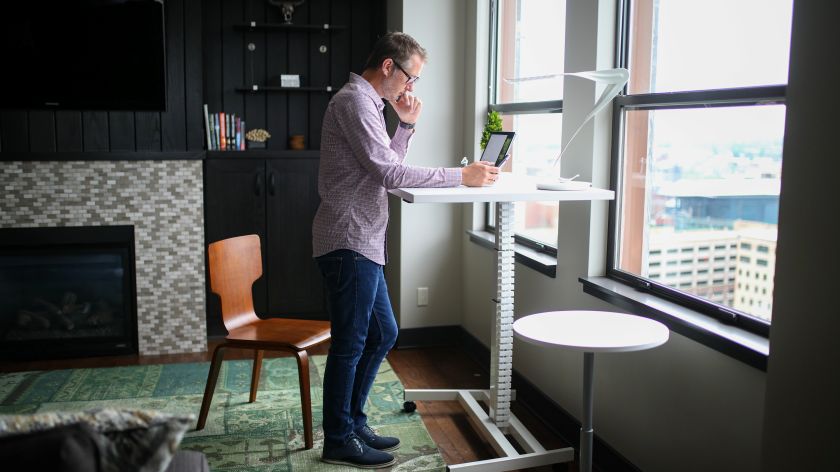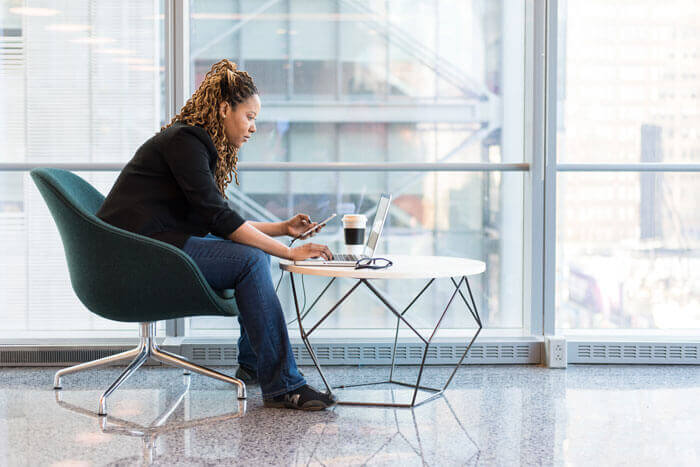Have you noticed how long you sit during a day? You’ve likely heard all of the reports in recent years about the perils of sitting for long periods. I thought that given a key element of my work is based on standing while presenting at conferences and courses, that it wasn’t relevant to me.
However, I am currently focussed on increasing my physical health and fitness and have been more conscious of how much I’m moving every day.
I recently counted up the average hours in a week that I spend sitting at my desk (course prep time, research, watching lectures online for the Master’s degree I am studying, emails etc etc), time spent sitting in bed writing fiction late into the night, or time spent in my studio working with clay.
I realised maybe time spent sitting is an issue I needed to consider.
Tasha Broomhall
Sitting For Long Periods
The idea that sitting for extended periods of time has a negative correlation with health outcomes is commonly accepted. However, what is also significant is that leisure time activity does not sufficiently compensate the relationship between sedentary behaviours and poor health outcomes.
When sitting doesn’t sit well
So, if you are sitting for extended periods, you can’t just fix it by doing some exercise. Rather, ideally, you should try to reduce the time spent sitting.
In reviewing my activities associated with extended periods of sitting, I realised that much of it was either unavoidable (work and study) or time I didn’t want to avoid (time spent on writing and clay work). I realised I was going to need to approach this issue creatively.

Stand Up For Your Health And Move
Where possible I started inviting clients and colleagues to engage in walking meetings, instead of sitting in an office or a café. In an average week this doesn’t add up to enough change for what I was trying to achieve though.
Many of my clients have adopted standing desks in recent years and there is plenty of research that supports the benefits of this for many individuals.
However, as my goal was to not only sit less, but to move more, I looked further for more options. And that was when I read an interview with the brilliant neuroscientist Norman Doidge where he talked about working, at least in part, from a treadmill desk.
My initial reaction was, hmm… I know multi-tasking can be a serious stress inducer for me and many others, and can be counterproductive. Yet, in the interview, Norman Doidge said that when we walk fast it triggers both brain growth factors and new cells in the brains memory system.
Benefits of standing desks and treadmill desks

Research supports that both standing desks and treadmill desks can be effective at reducing levels of sedentary behaviour, and do not appear to have a negative impact on productivity.
Each of these options though does come with risks and occupational health and safety protocols in workplaces may mean that treadmill desks (which have more potential benefits, but also more potential risks relating to possible accident and injury) do not become widespread in the workplace.
I spoke to some people from around the world who use treadmill desks and they all raved about the benefits they’ve reaped. And they all advised to start at a slow walking pace and build it up as you get used to combining the two activities; with most suggesting that it takes about three months to get used to the set-up.
Encouraged by the research and these recommendations, I set about purchasing a treadmill desk and it was surprisingly difficult to find one that could allow a reasonable walking pace to be of real benefit. I eventually purchased a treadmill and got a local metal framer to make me a desk frame to go over the top of it, to use as a desk. I then wall mounted my monitor behind the desk.
Committing to your health
Adding any exercise to the day has often been a challenge for me and so I knew that the best way to adapt a new behaviour is to try to map it to an existing behaviour. I will often spend time in the morning reading research or watching lectures online, so I made a commitment to myself that instead of doing that on my phone, or while sitting at my desk, I will now do it while walking on the treadmill.
And so for the last couple of months I’ve been doing this. So far, it has been a great way of increasing activity in my day. I am relatively uncoordinated, so I have learnt pretty quickly to not try to do anything involving typing while I’m walking, but I have managed to master using the mouse to navigate around the screen while I still walk.
While overall, further research is needed in this area, it is certainly working for me as a way to increase my movement, decrease sitting time, and hopefully with other changes, will assist in improving my general physical health.
Could standing or walking while working be of use to you?
References
Effect of Active Workstation on Energy Expenditure and Job Performance: A Systematic Review and Meta-analysis
The Impact of Active Workstations on Workplace Productivity and Performance: A Systematic Review
-
 Healthy Minds, Flourishing Workplaces | eLearning Course$198.00 inc.GST
Healthy Minds, Flourishing Workplaces | eLearning Course$198.00 inc.GST -
 Building Buoyancy | eLearning Course*$180.00 inc.GST
Building Buoyancy | eLearning Course*$180.00 inc.GST -
 Workplace Mental Health for Leaders | eLearning Course + Assessments$770.00 inc.GST
Workplace Mental Health for Leaders | eLearning Course + Assessments$770.00 inc.GST
Tap into our mental health expertise
Images: Austin Distell and TheStandingDesk (Unsplash)



